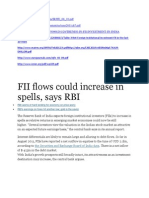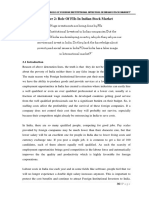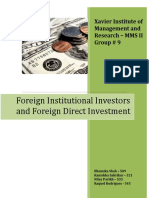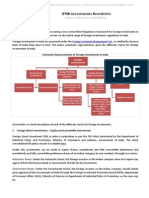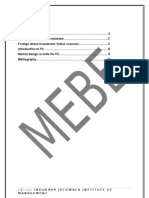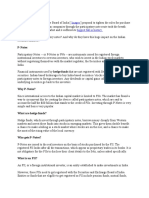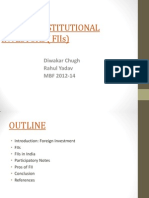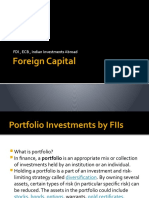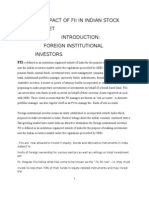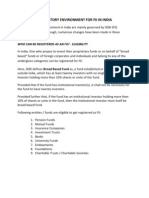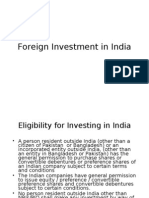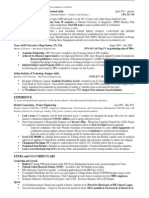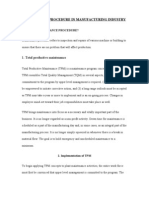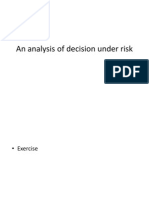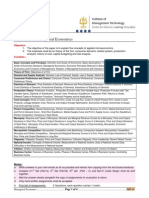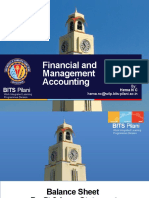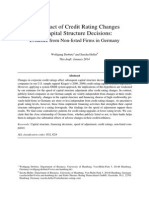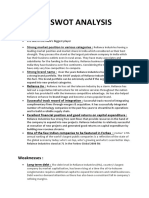Impact of Foreign Institutional Investment On Stock Market
Impact of Foreign Institutional Investment On Stock Market
Uploaded by
Vivek SahCopyright:
Available Formats
Impact of Foreign Institutional Investment On Stock Market
Impact of Foreign Institutional Investment On Stock Market
Uploaded by
Vivek SahOriginal Description:
Original Title
Copyright
Available Formats
Share this document
Did you find this document useful?
Is this content inappropriate?
Copyright:
Available Formats
Impact of Foreign Institutional Investment On Stock Market
Impact of Foreign Institutional Investment On Stock Market
Uploaded by
Vivek SahCopyright:
Available Formats
IMPACT OF FOREIGN INSTITUTIONAL INVESTMENT ON STOCK MARKET
----------------------------------------------------------------------------------------------------------------* Karan Walia **Dr. Rimpi Walia *** Monika Jain * ** *** Research Scholar, M.M. Institute of Management, Maharishi Markandeshwar University, Mullana- Ambala. Associate Professor, M.M. Institute of Management, Maharishi Markandeshwar University, Mullana- Ambala. Research Scholar, M.M. Institute of Management, Maharishi Markandeshwar University, Mullana- Ambala. ABSTRACT Foreign institutional investors have gained a significant role in Indian stock markets. The dawn of 21st century has shown the real dynamism of stock market and the various benchmarking of sensitivity index (Sensex) in terms of its highest peaks and sudden falls. In this context present paper examines the contribution of foreign institutional investment in sensitivity index (Sensex). Also attempts to understand the behavioral pattern of FII during the period of 2001 to 2010 and examine the volatility of BSE Sensex due to FII. The data for the study uses the information obtained from the secondary resources like website of BSE sensex. We attempted to explain the impact of foreign institutional investment on stock market and Indian economy. Also attempts to present the correlation between FII and BSE sensex by the Karl Pearson Coefficient of correlation test. KEYWORDS: FII (Foreign Institutional Investment), BSE Sensex, Correlation Between FII & BSE Sensex, Regulation Relating to FII Operation, Effect of FII on Indian Economy.
INTRODUCTION
FOREIGN INSTITUTIONAL INVESTOR: The term Foreign Institutional Investor is defined by SEBI as under: "Means an institution established or incorporated outside India which proposes to make investment in India in securities. Provided that a domestic asset management company or domestic portfolio manager who manages funds raised or collected or brought from outside India for investment in India on behalf of a sub-account, shall be deemed to be a Foreign Institutional Investor." Foreign Investment refers to investments made by residents of a country in financial assets and production process of another country. Entities covered by the term FII include Overseas pension funds, mutual funds, investment trust, asset management company, nominee company, bank, institutional portfolio manager, university funds, endowments, foundations, charitable trusts, charitable societies etc.(fund having more than 20 investors with no single investor holding more than 10 per cent of the shares or units of the fund) (GOI (2005)). FIIs can invest their own funds as well as invest on behalf of their overseas clients registered as such with SEBI. These client accounts that the FII manages are known as sub-accounts. The term is used most commonly in India to refer to outside companies investing in the financial markets of India. International institutional investors must register with Securities & Exchange Board of India (SEBI) to participate in the market. One of the major market regulations pertaining to FII involves placing limits on FII ownership in Indian companies. They actually evaluate the shares and deposits in a portfolio. WHY FIIS REQUIRED? FIIs contribute to the foreign exchange inflow as the funds from multilateral finance institutions and FDI (Foreign direct investment) are insufficient. Following are the some advantages of FIIs. It lowers cost of capital, access to cheap global credit. It supplements domestic savings and investments. It leads to higher asset prices in the Indian market. And has also led to considerable amount of reforms in capital market and financial sector.
INVESTMENTS BY FIIS There are generally two ways to invest for FIIs. EQUITY INVESTMENT 100% investments could be in equity related instruments or up to 30% could be invested in debt instruments i.e.70 (Equity Instruments): 30 (Debt Instruments) 100% DEBT 100% investment has to be made in debt securities only EQUITY INVESTMENT ROUTE: In case of Equity route the FIIs can invest in the following instruments: A. Securities in the primary and secondary market including shares which are unlisted, listed or to be listed on a recognized stock exchange in India. B. Units of schemes floated by the Unit Trust of India and other domestic mutual funds, whether listed or not. C. Warrants 100% DEBT ROUTE: In case of Debt Route the FIIs can invest in the following instruments: A. Debentures (Non Convertible Debentures, Partly Convertible Debentures etc.) B. Bonds C. Dated government securities D. Treasury Bills E. Other Debt Market Instruments It should be noted that foreign companies and individuals are not be eligible to invest through the 100% debt route. HISTORY OF FII India opened its stock market to foreign investors in September 1992, and in 1993, received portfolio investment from foreigners in the form of foreign institutional investment in equities. This has become one of the main channels of FII in India for foreigners. Initially, there were terms and conditions which restricted many FIIs to invest in India. But in the course of time, in order to attract more investors, SEBI has simplified many terms such as: The ceiling for overall investment of FII was increased 24% of the paid up capital of
Indian company. Allowed foreign individuals and hedge funds to directly register as FII. Investment in government securities was increased to US$5 billion. Simplified registration norms. PROCEDURE FOR REGISTRATION: The Procedure for registration of FII has been given by SEBI regulations. It states- no person shall buy, sell or otherwise deal in securities as a Foreign Institutional Investor unless he holds a certificate granted by the Board under these regulations. An application for grant of registration has to be made in Form A, the format of which is provided in the SEBI (FII) Regulations, 1995. THE ELIGIBILITY CRITERIA FOR APPLICANT SEEKING FII REGISTRATION IS AS FOLLOWS: Good track record, professional competence and financial soundness. Regulated by appropriate foreign regulatory authority in the same capacity/category where registration is sought from SEBI. Permission under the provisions of the Foreign Exchange Management Act, 1999 (FEMA) from the RBI. Legally permitted to invest in securities outside country or its incorporation/establishment. The applicant must be a fit and proper person. Local custodian and designated bank to route its transactions. ELIGIBLE SECURITIES A FII can make investments only in the following types of securities: Securities in the primary and secondary markets including shares, debentures and warrants of unlisted, to- be-listed companies or companies listed on a recognized stock exchange. Units of schemes floated by domestic mutual funds including Unit Trust of India, whether listed on a recognized stock exchange or not, and units of scheme floated by a Collective Investment Scheme. Government Securities
Derivatives traded on a recognized stock exchange like futures and options. FIIs can now invest in interest rate futures that were launched at the National Stock Exchange (NSE) on 31st August, 2009. Commercial paper. Security receipts REGULATION RELATING TO FII OPERATION Investment by FIIs is regulated under SEBI (FII) Regulations, 1995 and Regulation 5(2) of FEMA Notification No.20 dated May 3, 2000. SEBI acts as the nodal point in the entire process of FII registration. FIIs are required to apply to SEBI in a common application form in duplicate. A copy of the application form is sent by SEBI to RBI along with their 'No Objection' so as to enable RBI to grant necessary permission under FEMA. RBI approval under FEMA enables a FII to buy/sell securities on stock exchanges and open foreign currency and Indian Rupee accounts with a designated bank branch. FIIs are required to allocate their investment between equity and debt instruments in the ratio of 70:30. However, it is also possible for an FII to declare itself a 100% debt FII in which case it can make its entire investment in debt instruments. All FIIs and their sub-accounts taken together cannot acquire more than 24% of the paid up capital of an Indian Company. Indian Companies can raise the above mentioned 24% ceiling to the Sectoral Cap / Statutory Ceiling as applicable by passing a resolution by its Board of Directors followed by passing a Special Resolution to that effect by its General Body. Further, in 2008 amendments were made to attract more foreign investors to register with SEBI, these amendments are: The definition of broad based fund under the regulations was substantially widened allowing several more sub accounts and FIIs to register with SEBI. Several new categories of registration viz. sovereign wealth funds, foreign individual, foreign corporate etc. were introduced, Registration once granted to foreign investors was made permanent without a need to apply for renewal from time to time thereby substantially reducing the administrative burden, Also the application fee for foreign investors applying for registration has recently been reduced by 50% for FIIs and sub accounts
Also, institutional investors including FIIs and their sub-accounts have been allowed to undertake short-selling, lending and borrowing of Indian securities from February 1, 2008. OBJECTIVES To get the knowledge of stock market. To find out the relationship between the FIIs investment and stock market. To know the volatility of BSE Sensex due to FIIs. To study the behavioral pattern of FII in India during 2000 to 2010.
HYPOTHESIS There is close correlation between BSE Sensex volatility and FIIs.
REVIEW OF LITRATURE 1. Stanley Morgan (2002) has examined that FIIs have played a very important role in building up Indias forex reserves, which have enabled a host of economic reforms. Secondly, FIIs are now important investors in the countrys economic growth despite sluggish domestic sentiment. The Morgan Stanley report notes that FII strongly influence short-term market movements during bear markets. However, the correlation between returns and flows reduces during bull markets as other market participants raise their involvement reducing the influence of FIIs. Research by Morgan Stanley shows that the correlation between foreign inflows and market returns is high during bear and weakens with strengthening equity prices due to increased participation by other players. 2. Agarwal, Chakrabarti et al (2003) have found in their research that the equity return has a significant and positive impact on the FII. But given the huge volume of investments, foreign investors could play a role of market makers and book their profits, i.e., they can buy financial assets when the prices are declining thereby jacking-
up the asset prices and sell when the asset prices are increasing. Hence, there is a possibility of bi-directional relationship between FII and the equity returns. 3. P. Krishna Prasanna (2008) has examined the contribution of foreign institutional investment particularly among companies included in sensitivity index (Sensex) of Bombay Stock Exchange. Also examined is the relationship between foreign institutional investment and firm specific characteristics in terms of ownership structure, financial performance and stock performance. It is observed that foreign investors invested more in companies with a higher volume of shares owned by the general public. The promoters holdings and the foreign investments are inversely related. Foreign investors choose the companies where family shareholding of promoters is not substantial. Among the financial performance variables the share returns and earnings per share are significant factors influencing their investment decision. 4. Gurucharan Singh (2004) highlighted that the securities market in India has come a long way in terms of infrastructure, adoption of best international practices and introduction of competition. Today, there is a need to review stock exchanges and improve the liquidity position of various scrips listed on them. A study conducted by the World Bank (1997) reports that stock market liquidity improved in those emerging economies that received higher foreign investments. 5. Anand Bansal and J.S. Pasricha (2009) studied the impact of market opening to FIIs on Indian stock market behaviour. They empirically analyze the change of market return and volatility after the entry of FIIs to Indian capital market and found that while there is no significant change in the Indian stock market average returns; volatility is significantly reduced after India unlocked its stock market to foreign investors. In the next section we are discussing the data sources and methodology of the study. 6. Kumar (2001) investigated the effects of FII inflows on the Indian stock market represented by the Sensex using monthly data from January 1993 to December 1997. Kumar (2001) inferred that FII investments are more driven by Fundamentals and they do not respond to short-term changes or technical position of the market. In testing whether Net FII Investment (NFI) has any impact on Sensex, a regression of NFI was estimated on lagged values of the first difference of NFI, first difference of Sensex and one lagged value of the error correction term (the residual obtained by estimating the regression between NFI and Sensex). The study concluded that Sensex causes NFI. Similarly, regression with Sensex as dependent variable showed that one month lag of NFI is significant, meaning that there is causality from FII to Sensex. This finding is in
contradiction with the findings of Rai and Bhanumurthy (2003) who did not find any causation from FII to return in BSE using similar data between 1994 and 2002. However, Rai and Bhanumurthy have also found significant impact of return in BSE on NFI. DISCUSSION INFLUENCE OF FII ON INDIAN MARKET Positive fundamentals combined with fast growing markets have made India an attractive destination for foreign institutional investors (FIIs). Portfolio investments brought in by FIIs have been the most dynamic source of capital to emerging markets in 1990s. At the same time there is unease over the volatility in foreign institutional investment flows and its impact on the stock market and the Indian economy. Apart from the impact they create on the market, their holdings will influence firm performance. For instance, when foreign institutional investors reduced their holdings in Dr.Reddys Lab by 7% to less than 18%, the company dropped from a high of around US$30 to the current level of below US$15. This 50% drop is apparently because of concerns about shrinking profit margins and financial performance. These instances made analysts to generally claim that foreign portfolio investment has a short term investment horizon. Growth is the only inclination for their investment. Some major impact of FII on stock market: They increased depth and breadth of the market. They played major role in expanding securities business. Their policy on focusing on fundamentals of share had caused efficient pricing of share. These impacts made the Indian stock market more attractive to FII & also domestic investors. The impact of FII is so high that whenever FII tend to withdraw the money from market, the domestic investors fearful and they also withdraw from market.
(TABLE-01) FII INVESTMENT 2000-01 TO 2011-12 TILL NOV30, 2011(IN INR CRORES)
Financial year Equity Debt Net Investment 2000-2001 10,206.7 -273.3 9,933.4 2001-2002 8,072.2 690.4 8,762.6 2002-2003 2,527.2 162.1 2,689.3 2003-2004 39,959.7 5,805 45,764.7 2004-2005 44,122.7 1,758.6 45,881.3 2005-2006 48,800.5 -7,333.8 41,466.7 2006-2007 25,235.7 5,604.7 30,840.4 2007-2008 53,403.8 12,775.3 66,179.1 2008-2009 -47,706.2 1,895.2 -45,811.0 2009-2010 110,220.6 32,437.7 142,658.3 2010-2011 110,120.8 36,317.3 146,438.1 2011-2012(till -311.2 8814.9 8503.7 November 2011) * The data presented above is compiled on the basis of reports submitted to SEBI by custodians and constitutes trades conducted by FIIs on and up to the previous trading day(s). FIIs not only enhance competition in financial markets, but also improve the alignment of asset prices to fundamentals. FIIs in particular are known to have good information and low transaction costs. By aligning asset prices closer to fundamentals, they stabilize markets. In addition, a variety of FIIs with a variety of risk-return preferences also help in dampening volatility. IMPROVING CAPITAL MARKETS: FIIs as professional bodies of asset managers and financial analysts enhance competition and efficiency of financial markets. By increasing the availability of riskier long term capital for projects, and increasing firms incentives to supply more information about them, the FIIs can help in the process of economic development. IMPROVED CORPORATE GOVERNANCE: Good corporate governance is essential to overcome the principal-agent problem between share-holders and management. Information asymmetries and incomplete contracts between share-holders and management are at the root of the agency costs. Bad corporate governance makes
equity finance a costly option. With boards often captured by managers or passive, ensuring the rights of shareholders is a problem that needs to be addressed efficiently in any economy. Incentives for shareholders to monitor firms and enforce their legal rights are limited and individuals with small share-holdings often do not address the issue since others can free-ride on their endeavor. FIIs constitute professional bodies of asset managers and financial analysts, who, by contributing to better understanding of firms operations, improve corporate governance. Among the four models of corporate control - takeover or market control via equity, leveraged control or market control via debt, direct control via equity, and direct control via debt or relationship banking-the third model, which is known as corporate governance movement, has institutional investors at its core. In this third model, board representation is supplemented by direct contacts by institutional investors. NEGATIVE IMPACT: If we see the market trends of past few recent years it is quite evident that Indian equity markets have become slaves of FIIs inflow and are dancing to their tune. And this dependence has to a great extent caused a lot of trouble for the Indian economy. Some of the factors are: A. POTENTIAL CAPITAL OUTFLOWS: Hot money refers to funds that are controlled by investors who actively seek short-term returns. These investors scan the market for short-term, high interest rate investment opportunities. Hot money can have economic and financial repercussions on countries and banks. When money is injected into a country, the exchange rate for the country gaining the money strengthens, while the exchange rate for the country losing the money weakens. If money is withdrawn on short notice, the banking institution will experience a shortage of funds. B. INFLATION: Huge amounts of FII fund inflow into the country creates a lot of demand for rupee, and the RBI pumps the amount of Rupee in the market as a result of demand created. This situation leads to excess liquidity thereby leading to inflation where too much money chases too few goods. C. PROBLEM TO SMALL INVESTORS: The FIIs profit from investing in emerging financial stock markets. If the cap on FII is high then they can bring in huge amounts of funds in the countrys stock markets and thus have great influence on the way the stock markets behaves, going up or down. The FII buying pushes the stocks up and
their selling shows the stock market the downward path. This creates problems for the small retail investor, whose fortunes get driven by the actions of the large FIIs. D. ADVERSE IMPACT ON EXPORTS: FII flows leading to appreciation of the currency may lead to the exports industry becoming uncompetitive due to the appreciation of the rupee. BSE SENSEX AND FII INVESTMENT CORRELATION Sensex is the commonly used name for the Bombay Stock Exchange Sensitive Index an index Composed of 30 of the largest and most actively traded stocks on the Bombay Stock Exchange (BSE). The term FII is used most commonly in India to refer to outside companies investing in the financial markets of India. FII investment is frequently referred to as hot money for the reason that it can leave the country at the same speed at which it comes in. In country like India; statutory agencies like SEBI have prescribed norms to register FIIs and also to regulate such investments flowing in through FIIs. (TABLE 02) BSE SENSEX AND FII (IN RS CR.) Years 2000 2001 2002 2003 2004 2005 2006 2007 2008 2009 2010 Sensex Value (points) 3,972 3,262 3,377 5,838 6,602 9,397 13,786 20,286 9,647 17,464 20,509 Net Investment of FII 6,510.9 12,494.8 3,677.9 35,153.8 42,049.1 41,663.5 40,589.2 80,914.8 -41,215.5 87,987.6 179,674.6
This table shows the relationship between Sensex value and FII investment.
(TABLE 03) FII & BSE SENSEX CORRELATION Yea rs 200 1 200 2 200 3 200 4 200 5 200 6 200 7 200 8 200 9 201 0 Tota l Sensex Deviation( Value(X) dx) 11016.8 3,262 -7,755 3,377 5,838 6,602 9,397 13,786 20,286 9,647 17,464 20,509 110,168 -7,640 -5,179 -4,415 -1,620 2,769 9,269 1,370 6,447 9,492 0 Standard Deviation 60136923.04 5866544.04 26819969.44 19490459.04 2623752.04 7668468.64 85918068.64 1876352.04 41566387.84 90101860.84 394568785.6 FII (Y) 12,494.8 0 3,677.90 35,153.8 0 42,049.1 0 41,663.5 0 40,589.2 0 80,914.8 0 41,215.5 0 87,987.6 0 179,674. 60 482,989. 80 Deviation(d Standard y) Devaition 48298.98 -35,804.18 128193930 5 -44,621.08 199104078 0 -13,145.18 172795757. 2 -6,249.88 39061000.0 1 -6,635.48 44029594.8 3 -7,709.78 59440707.6 5 32,615.82 106379171 4 -89,514.48 801284213 0 39,688.62 157518655 8 131,375.62 172595535 30 0.00 314996810 77 dxdy 277654255.1 340896127 68076258.18 27591970.22 10748150.5 -21349922.78 302322558.7 122616934.7 255880470.9 1247043660 2631480463
11016.8
56124.5766 8
Karl Pearson coefficient of Correlation
It has been founded by the study (Table: 3) that BSE sensex and foreign institutional investment has followed a close relationship. ThePearson correlation values indicate positive correlation between the foreign institutional investments and the movement of sensex(pearson correlation value is (0.746424196 ). CONCLUSION On the basis of above discussion and data analysis, It is clear that the FIIs are influencing the sensex movement to a greater extent. Further it is evident that the sensex has increased when there are positive inflows of FIIs and there were decrease in sensex when there were negative FII inflows. The Pearson correlation values indicate positive correlation between the foreign institutional investments and the movement of sensex (pearson correlation value is 0.746424196). REFERENCES Errunza, Vihang. (2001). "Foreign Portfolio Equity Investments, Financial Liberalization and Economic Development", Review of International Economics, Vol. 9, Issue 4, Special Issue : International Financial Liberalization, Capital Flows and Exchange Rate Regimes.
Chakraborty tanupa (2007), Foreign Institutional Investment Flows and Indian Stock Market Returns . A Cause and Effect Relationship Study, Indian Accounting Review, Vol: 11, No: 1, June 2001, pp: 35 48. Samal, C. Kishore (1997), Emerging Equity Market in India: Role of Foreign Institutional Investors, Economic and Political Weekly, Vol. 32, No. 42. Kumar Saji (2006), FIIs Vs. SENSEX: An Emerging Paradigm, Treasury Management, ICFAI University Press, February. Ravi Akula, (2011), An overview of foreign institutional investment in India, Indian journal of Commerce & Management studies, Vol: 2, Issue: 1, January 2011, pp: 100-104. Kumar, S. (2001). Does the Indian Stock Market Play to the tune of FII Investments? An Empirical Investigation. ICFAI Journal of Applied Finance 7 (3): 36-44. Mazumdar, T. (2004). FII Inflows to India; Their effect on stock market liquidity. ICFAI Journal of Applied Finance 10 (7): 5-20. Prasanna, P.K (2008), Foreign Institutional Investors: Investment preferences in India, JOAAG, Vol 3, No-3. Rai Kulwant & Bhanumurthy N R (2003) : Determinants of Foreign Institutional Investment in India, Journal: Journal of Institutional Investors . Vol 15. Publisher: Emerald Group Publishing Limited. Stanley Morgan (2002),FIIs influence on Stock Market, Journal: Journal of impact of Institutional Investors on ism. Vol 17. Publisher: Emerald Group Publishing Limited. Ahmad, Khan Masood; Ashraf, Shahid and Ahmed, Shahid (2005), Foreign Institutional Investment Flows and Equity Returns in India, The IUP Journal of Applied Finance, March, pp. 16-30. Batra, A (2003), The Dynamics of Foreign Portfolio Inflows and Equity Returns in India,ICRIER Working Paper, No. 109, New Delhi. Chakrabarti, R (2001), FII Flows to India: Nature and Causes, Money and Finance, Vol. 2, Issue 7, Oct-Dec. Dey, Subarna and Mishra, Bishnupriya (2004), Causal Relationship between Foreign Institutional Investment and Indian Stock Market, The IUP Journal of Applied Finance,December, pp.61-80.
Kumar, SSS (2006), Role of Institutional Investors in Indian Stock Market, Impact, July-December, pp.76-80. Mukherjee, P, Bose, S and Coondoo, D (2002), Foreign Institutional Investment in the Indian Equity Market, Money and Finance, 3, pp. 21-51. Trivedi, P, and A Nair (2003), Determinants of FII Investment Inflow to India Presented in Fifth Annual Conference on Money and Finance in the Indian Economy, Indira Gandhi Institute of Development Research, January 30-February 1, 2003. Han, B. and Wang, Q. (2004). Institutional investment constraints and stock prices. Dice Center for Research in Financial Economics 2004, Working Paper No,2004-24. Pal, Parthapratim (1998): Foreign Portfolio Investment in Indian Equity Markets: Has the Economy Benefited? Economic and Political Weekly, Vol. 33, No. 11, March 14. Pethe, Abhay and Ajit Karnik (2000): Do Indian Stock Markets Matter? Stock Market Indices and Macro-economic Variables Economic and Political Weekly, January 29. Samal, Kishor C., (1997): Emerging Equity Market in India: Role of Foreign Institutional Investors Economic and Political Weekly, Vol. 32, No. 42, October 18. ***********************
You might also like
- FII Investment in IndiaDocument38 pagesFII Investment in IndiaKhushbu GosherNo ratings yet
- Impact of FII's On Indian Stock Markets: ManagementDocument5 pagesImpact of FII's On Indian Stock Markets: ManagementpriyakedNo ratings yet
- FII Flows Could Increase in Spells, Says RBI: The Securities and Exchange Board of India DataDocument11 pagesFII Flows Could Increase in Spells, Says RBI: The Securities and Exchange Board of India DataPooja MaanNo ratings yet
- Project Title "Impact of Fii'S On Indian Stock Market"Document12 pagesProject Title "Impact of Fii'S On Indian Stock Market"Ganaie AhmadNo ratings yet
- Fiis and Their Influence On Indian Capital MarketsDocument8 pagesFiis and Their Influence On Indian Capital MarketsRohit GuptaNo ratings yet
- Definition of 'Foreign Institutional Investor - FII'Document24 pagesDefinition of 'Foreign Institutional Investor - FII'Preeja ChandranNo ratings yet
- Foreign Institutional InvestorDocument6 pagesForeign Institutional Investorhardik27hpNo ratings yet
- IMPACT OF FOREIGN INSTITUTIONAL INVESTORS (FIIs) AND MACRO ECONOMIC FACTORS ON INDIAN STOCK MARKETSDocument27 pagesIMPACT OF FOREIGN INSTITUTIONAL INVESTORS (FIIs) AND MACRO ECONOMIC FACTORS ON INDIAN STOCK MARKETSece_shreyas100% (2)
- FinalDocument21 pagesFinalankushga100% (6)
- Foreign Institutional InvestmentDocument61 pagesForeign Institutional InvestmentPrashantChauhanNo ratings yet
- Foreign Direct InvestmentDocument6 pagesForeign Direct Investmentrohitalbert5No ratings yet
- Role of Fii in Share MarketDocument7 pagesRole of Fii in Share MarketMukesh Kumar MishraNo ratings yet
- The Role of FIIDocument3 pagesThe Role of FIIkushalsaxenaNo ratings yet
- Answer Paper-1 MBL2Document7 pagesAnswer Paper-1 MBL2Matin Ahmad KhanNo ratings yet
- Foreign Instituitional InvestorsDocument8 pagesForeign Instituitional InvestorsJayneel JadejaNo ratings yet
- Group-6 Presentation On FIIDocument42 pagesGroup-6 Presentation On FIIPankaj Kumar Bothra100% (1)
- ProjectDocument16 pagesProjectnazir7864No ratings yet
- Article Foreign Regulatory Environment AssessmentDocument4 pagesArticle Foreign Regulatory Environment AssessmentAdarsh BhandariNo ratings yet
- Foreign Investor ProjectDocument22 pagesForeign Investor ProjectwaghaNo ratings yet
- Chapter 2: Role of Fiis in Indian Stock MarketDocument25 pagesChapter 2: Role of Fiis in Indian Stock MarketWise MoonNo ratings yet
- FII Vs FDIDocument10 pagesFII Vs FDIChetan HardikarNo ratings yet
- Mohan Babu Final ProjectDocument50 pagesMohan Babu Final ProjectMohan Babu Nandyala0% (1)
- Foreign Investment Regime in IndiaDocument4 pagesForeign Investment Regime in IndiaKriti KaushikNo ratings yet
- Institutional InvestorsDocument8 pagesInstitutional InvestorsVinit BhindeNo ratings yet
- FII and FDIDocument24 pagesFII and FDIbhumika_shah_9No ratings yet
- Regulatory Framework For Foreign Investments in India Part I An OverviewDocument4 pagesRegulatory Framework For Foreign Investments in India Part I An OverviewRaviNo ratings yet
- Table of Content: Indukaka Ipcowala Institute of ManagementDocument11 pagesTable of Content: Indukaka Ipcowala Institute of ManagementMvs LegerdemainNo ratings yet
- Participatory NotesDocument3 pagesParticipatory NotesAmit KumarNo ratings yet
- Foreign Institutional InvestorDocument22 pagesForeign Institutional InvestorAshish Baniwal100% (1)
- The Indian Private Equity ScenarioDocument5 pagesThe Indian Private Equity Scenarioveer.cmNo ratings yet
- 36 Participatory NotesDocument4 pages36 Participatory NoteslenovojiNo ratings yet
- FiiDocument9 pagesFiiRohan SinghNo ratings yet
- FDI in MediaDocument9 pagesFDI in MediaShreya BansalNo ratings yet
- A Securities and Exchange Board of IndiaDocument4 pagesA Securities and Exchange Board of IndiaVenu KumarNo ratings yet
- FII Investment in IndiaDocument2 pagesFII Investment in IndiapoojathxNo ratings yet
- Final Economics ProjectDocument15 pagesFinal Economics ProjectNishant ShahNo ratings yet
- Fii Report - Docx SandeepDocument23 pagesFii Report - Docx Sandeepaadishjain007No ratings yet
- Powerpoint Presentation On FIIDocument13 pagesPowerpoint Presentation On FIIManali Rana100% (1)
- Do Fiis Impact Volatility of Indian Stock Market ?: Jatinder LoombaDocument14 pagesDo Fiis Impact Volatility of Indian Stock Market ?: Jatinder LoombaNidhi KhandelwalNo ratings yet
- Foreign Institutional Investor: Sandipan DasDocument22 pagesForeign Institutional Investor: Sandipan DasSandipanDasNo ratings yet
- NTCC PDFDocument36 pagesNTCC PDFSimran BhatiaNo ratings yet
- Foreign Institutional InvestorsDocument14 pagesForeign Institutional InvestorsGaurav SharmaNo ratings yet
- 1515494390BSE_P9_M25_e-textDocument8 pages1515494390BSE_P9_M25_e-texttamizhanmusickingNo ratings yet
- Participatory Notes: Presented by Jyoti Kumari Tripti Majhi NoopurDocument21 pagesParticipatory Notes: Presented by Jyoti Kumari Tripti Majhi NoopurrathnakotariNo ratings yet
- Foreign Capital: FDI, ECB, Indian Investments AbroadDocument13 pagesForeign Capital: FDI, ECB, Indian Investments AbroadrishugNo ratings yet
- L Project of FiiDocument53 pagesL Project of Fiimanisha_mithibaiNo ratings yet
- Assignment On IbDocument11 pagesAssignment On IbRajashree MuktiarNo ratings yet
- Roles and Impact of FIIDocument16 pagesRoles and Impact of FIIAbhishek MandloiNo ratings yet
- Regulatory Environment For Fii in IndiaDocument7 pagesRegulatory Environment For Fii in IndiaDivya BansalNo ratings yet
- Need For Bombay Stock ExchangeDocument6 pagesNeed For Bombay Stock ExchangeShubham DaveNo ratings yet
- Venture Capital Fund in IndiaDocument5 pagesVenture Capital Fund in IndiaThinlay ChukkiNo ratings yet
- FII (Foreign Institutional Investor) in India and Its Impact On Indian Stock Market For Last Five YearsDocument37 pagesFII (Foreign Institutional Investor) in India and Its Impact On Indian Stock Market For Last Five YearsAbhishek RathodNo ratings yet
- Foreign Investment in IndiaDocument13 pagesForeign Investment in Indiagolu1985No ratings yet
- Mastering the Market: A Comprehensive Guide to Successful Stock InvestingFrom EverandMastering the Market: A Comprehensive Guide to Successful Stock InvestingNo ratings yet
- Indian Mutual funds for Beginners: A Basic Guide for Beginners to Learn About Mutual Funds in IndiaFrom EverandIndian Mutual funds for Beginners: A Basic Guide for Beginners to Learn About Mutual Funds in IndiaRating: 3.5 out of 5 stars3.5/5 (8)
- A Practical Approach to the Study of Indian Capital MarketsFrom EverandA Practical Approach to the Study of Indian Capital MarketsNo ratings yet
- Building Information Modeling: An Academic PerspectiveDocument11 pagesBuilding Information Modeling: An Academic PerspectiveVivek SahNo ratings yet
- BechtelDocument1 pageBechtelVivek SahNo ratings yet
- AsDocument4 pagesAsVivek SahNo ratings yet
- 6 Customer ProfitabilityDocument23 pages6 Customer ProfitabilityVivek SahNo ratings yet
- Golf LogixDocument40 pagesGolf LogixVivek SahNo ratings yet
- Assignment 1Document6 pagesAssignment 1Vivek SahNo ratings yet
- Steps To Build Your PortfolioDocument3 pagesSteps To Build Your PortfolioVivek SahNo ratings yet
- Financial Accounting 2 - Paper C7: Presentation By: Farhan Kasbati 2006Document34 pagesFinancial Accounting 2 - Paper C7: Presentation By: Farhan Kasbati 2006causeway.isNo ratings yet
- Maintenance Procedure in Manufacturing IndustryDocument6 pagesMaintenance Procedure in Manufacturing IndustryAdeyinka Caudry HajiNo ratings yet
- Tremor Model Validation by WystupDocument52 pagesTremor Model Validation by WystupMLKamNo ratings yet
- PERSONAL FINANCE Course OutlineDocument3 pagesPERSONAL FINANCE Course OutlineMaina MwaiNo ratings yet
- Assignment OF Accounting Principles IN Ratio Analysis & Fund Flow StatementDocument10 pagesAssignment OF Accounting Principles IN Ratio Analysis & Fund Flow StatementIshu AroraNo ratings yet
- Session 4 Prospect TheoryDocument41 pagesSession 4 Prospect TheoryLokesh Khatwani50% (2)
- Economics Cheat Sheet: by ViaDocument6 pagesEconomics Cheat Sheet: by ViaAnaze_hNo ratings yet
- SEBI Penetration of Mutual Funds in IndiaDocument62 pagesSEBI Penetration of Mutual Funds in Indiasrikan2No ratings yet
- IMT-20 - Managerial EconomicsDocument4 pagesIMT-20 - Managerial EconomicsPramod KumarNo ratings yet
- TERM PAPER On ACIDocument15 pagesTERM PAPER On ACISaif Uddin Forhad100% (1)
- SAP FI AND SAP CO CoursesDocument4 pagesSAP FI AND SAP CO CoursesNaseer SapNo ratings yet
- Session 3 - JournalDocument27 pagesSession 3 - JournalanandakumarNo ratings yet
- Sec V CaDocument6 pagesSec V Caapril75No ratings yet
- Theme Park Based On Augmented Reality in Urban Areas PDFDocument20 pagesTheme Park Based On Augmented Reality in Urban Areas PDFPankaj ChoudharyNo ratings yet
- India, Country That Occupies The Greater Part of South Asia. It Is ADocument1 pageIndia, Country That Occupies The Greater Part of South Asia. It Is AangellicaNo ratings yet
- CBS Corporation Purchased 10Document12 pagesCBS Corporation Purchased 10Stella SabaoanNo ratings yet
- Making Sense of A Complex WorldDocument16 pagesMaking Sense of A Complex WorldciaranharronNo ratings yet
- Positive Accounting Theory, Political Costs and Social Disclosure Analyses: A Critical LookDocument23 pagesPositive Accounting Theory, Political Costs and Social Disclosure Analyses: A Critical LookFridRachmanNo ratings yet
- Theta 2Document2 pagesTheta 2Nur SyahirahNo ratings yet
- An Analysis of Indian Foreign Trade in Present EraDocument8 pagesAn Analysis of Indian Foreign Trade in Present EraIJEMR JournalNo ratings yet
- SSRN-The Impact of Credit Rating Changes On Capital Structure Decisions GermanyDocument35 pagesSSRN-The Impact of Credit Rating Changes On Capital Structure Decisions GermanyHabiba AshrafNo ratings yet
- Stock Trading LedgerDocument23 pagesStock Trading LedgerRoberto TejadaNo ratings yet
- Project - 16.7.2022Document67 pagesProject - 16.7.2022Swathi JNo ratings yet
- Da Nang Rubber JSC (DRC - HSX) : Update ReportDocument7 pagesDa Nang Rubber JSC (DRC - HSX) : Update ReportDuy Tài NgôNo ratings yet
- Illustrative-Financial-Statements - IGAAP PDFDocument65 pagesIllustrative-Financial-Statements - IGAAP PDFSubhash BhatNo ratings yet
- Industry Analysis Coca ColaDocument13 pagesIndustry Analysis Coca ColacellouNo ratings yet
- Risk MGMT & Hedging Strategies in Natural Gas IndustryDocument26 pagesRisk MGMT & Hedging Strategies in Natural Gas Industryrathneshkumar100% (5)
- Ril Swot AnalysisDocument5 pagesRil Swot Analysistulasi nandamuriNo ratings yet
- IAII FINAL EXAM Maual SET ADocument9 pagesIAII FINAL EXAM Maual SET ALovely Anne Dela CruzNo ratings yet
- Metropoly Whitepaper.2f2bbf5b62b19e4afb0dDocument45 pagesMetropoly Whitepaper.2f2bbf5b62b19e4afb0dGi KayNo ratings yet


